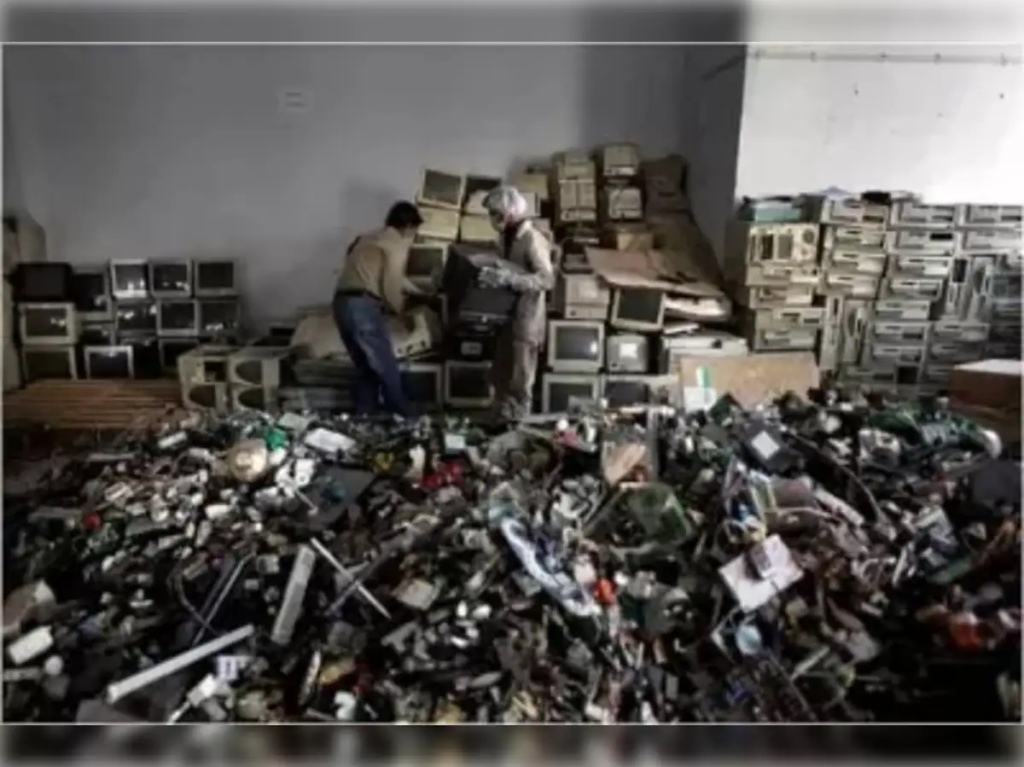| UPSC Relevance;Prelims –Battery Waste Management Rules, 2022,Extended Producer Responsibility (EPR),Circular Economy,Battery Energy Storage Systems (BESS) Mains-GS Paper 3 – Environment, Economy, Science & Technology Resource efficiency and circular economy Waste management and pollution control E-waste rules and extended producer responsibility Green energy transition and battery recycling technology |
Why in News?
India’s rapid shift towards electrification, especially in the electric vehicle (EV) and renewable energy sectors, has led to an exponential rise in lithium battery usage. However, the current framework for battery waste recycling—notably the Battery Waste Management Rules (2022)—faces serious challenges in implementation, particularly around the Extended Producer Responsibility (EPR) floor price, threatening both environmental safety and the circular economy vision.

Background
- India aims to achieve Net Zero carbon emissions by 2070, which requires large-scale electrification in transport and energy sectors.
- Lithium-ion batteries are critical for EVs and Battery Energy Storage Systems (BESS) in renewable energy.
- Battery demand is projected to increase from 4 GWh (2023) to 139 GWh (by 2035).
- Improper battery disposal leads to hazardous leakage of toxic materials into the environment.
- In 2022, India generated 1.6 million metric tonnes of e-waste, including 7,00,000 tonnes of lithium batteries.
- The Battery Waste Management Rules, 2022 introduced Extended Producer Responsibility (EPR) to create a circular system for collection, reuse, and recycling.
Key Challenges in Battery Waste Management in India
As India rapidly shifts towards electric mobility and digital devices, battery waste is emerging as a critical environmental and economic issue. While policies like the Battery Waste Management Rules, 2022 aim to regulate recycling and recovery, there are serious challenges on the ground.
1️⃣ Low EPR Floor Price: Undervaluing Recycling
EPR (Extended Producer Responsibility) means producers must ensure safe collection and recycling of used batteries. However, the floor price — the amount paid to recyclers per kg of battery waste — is too low.
Why It’s a Problem:
- Recyclers can’t cover costs of modern recycling facilities, which need high-end technology, trained labour, and transport logistics.
- This makes formal recycling economically unviable, discouraging private investment.
- As a result, informal and fake recyclers issue fraudulent EPR certificates or dump toxic waste without treatment — just as seen earlier with plastic waste frauds.
Example: Some firms in Delhi and UP have been caught issuing fake compliance certificates for plastic waste — a practice now being replicated in battery waste.
2️⃣ Economic and Environmental Risks
India is not just losing out on clean recycling — it’s also missing the opportunity to recover valuable resources like:
- Lithium
- Cobalt
- Nickel
These are strategic minerals needed for EVs, electronics, and defence. When batteries are dumped instead of recycled:
- India faces over $1 billion in foreign exchange loss by 2030 (due to import dependence).
- Soil and groundwater contamination from heavy metals becomes a long-term health hazard.
Example: In states like Jharkhand and Maharashtra, groundwater near informal battery recycling units has shown high lead and cadmium levels — a serious public health concern.
3️⃣ Weak Corporate Compliance: Double Standards
Many multinational battery producers operating in India do not follow the same safety or recycling standards here as they do in Europe or the U.S.
What Happens:
- They outsource waste to unregulated agents or simply underreport their waste.
- This leads to low transparency and undermines India’s circular economy vision.
Example: Several EV battery makers submit partial compliance reports to the Central Pollution Control Board (CPCB), exploiting gaps in monitoring.
4️⃣ Lack of Enforcement and Monitoring
Even though laws exist, implementation is weak.
- Auditing of EPR certificates is poor.
- Penalties for non-compliance are rare or insignificant.
- The informal sector, which handles a large volume of battery waste, is untrained and unregulated — leading to unsafe dismantling and open-air burning.
Example: In cities like Meerut and Ludhiana, battery dismantling often happens in backyard setups, exposing workers (often children) to toxic fumes and risking explosions.
Government Initiatives and International Comparison
India’s Policy Response
In 2022, the Government of India introduced the Battery Waste Management Rules, which marked a key regulatory step in addressing the growing challenge of used battery disposal.
Key Features:
- Extended Producer Responsibility (EPR) made mandatory for all producers and importers of batteries.
- Producers are now legally obligated to:
- Collect used batteries from consumers
- Ensure environmentally safe recycling through certified recyclers
- Submit proof of compliance via EPR certificates to regulatory bodies like the CPCB
This is a significant shift from earlier policies, which focused only on voluntary or informal collection systems.
How Does India Compare Globally?
While India has made progress on regulation, its economic incentives lag far behind global standards.
- In the United Kingdom, the recycling incentive for battery waste is ₹600/kg (approx.), encouraging high-quality, safe recycling.
- In contrast, India is considering offering less than ₹150/kg — even after adjusting for Purchasing Power Parity (PPP).
Why This Matters:
- Low incentives make it difficult for recyclers to adopt clean technology or expand capacity.
- It discourages formal sector participation and lets unsafe informal practices continue unchecked.
Without financial viability, even the best-intentioned laws risk becoming ineffective on the ground.
Way Forward: Fixing the Missing Link in Battery Waste Management
India must shift from policy intent to effective on-ground action. Addressing battery waste requires economic rationality, regulatory strength, and inclusive planning.
1. Recalibrate the EPR Floor Price
Problem: The current proposed price for EPR credits is too low to cover the real costs of clean, safe recycling.
Solution:
- Determine a realistic and fair price per kg of battery waste, factoring in:
- Collection
- Safe dismantling
- Transport
- Recovery of critical minerals
- Use global benchmarks (e.g. ₹600/kg in the UK) and adjust for Indian conditions like labour and logistics costs.
This would ensure legitimate recyclers can operate sustainably and discourage underpricing by informal players.
2. Strengthen Monitoring and Enforcement
Problem: Weak oversight allows fraud and unsafe practices to flourish.
Solution:
- Develop digital tracking systems to monitor EPR credits, collection, and recycling activities in real time.
- Use blockchain or tamper-proof certificates for accountability.
- Impose strict penalties for:
- Issuing fake compliance certificates
- Underreporting waste volumes
- Non-compliance with recycling norms
Such systems are already in use for plastic waste in the EU and can be adapted to India’s context.
3. Integrate the Informal Sector
Problem: India’s informal recyclers manage a large share of battery waste — but often do so unsafely and without recognition.
Solution:
- Offer technical training, protective gear, and legal recognition to informal workers
- Encourage formation of producer-informal partnerships
- Gradually bring them under regulated frameworks without displacement
This not only improves safety but also increases the system’s collection and processing capacity.
4. Promote Industry Collaboration
Problem: OEMs often externalise recycling costs, and there is poor coordination across stakeholders.
Solution:
- Foster public-private dialogue involving:
- Recyclers
- Producers
- Government bodies
- Mandate that Original Equipment Manufacturers (OEMs) absorb the cost of recycling rather than shifting it to consumers
Globally, companies like Apple and Tesla are increasingly taking responsibility for their products’ end-of-life processing — India must push for the same.
Conclusion
As India accelerates towards a low-carbon economy, the management of battery waste becomes both an environmental necessity and an economic opportunity. Fixing the EPR pricing regime, regulating the recycling ecosystem, and integrating the informal sector can transform battery waste from a problem into a pillar of India’s green growth strategy.
UPSC Prelims PYQ
Q. Which of the following statements are correct about the e-waste management rules, 2016?(2019)
- Manufacturers are required to collect back end-of-life electronic products under Extended Producer Responsibility (EPR).
- The rules apply only to large-scale industries and not to MSMEs.
- The rules give freedom to producers to decide the collection mechanism under EPR.
Select the correct answer using the code given below:
(A) 1 and 2 only
(B) 1 and 3 only
(C) 2 and 3 only
(D) 1, 2 and 3
Correct Answer: (B) 1 and 3 only
UPSC Mains pyqs-
“E-waste management has assumed significant importance in recent years in the context of the circular economy.” Evaluate the status of e-waste management in India and formulate a robust strategy for its improvement.(15 marks, 250 words) (2022)
SOURCE- THE HINDU
Found this helpful?
Bookmark for revision, Practice the mains question, and
Share with fellow aspirants! THANK YOU
